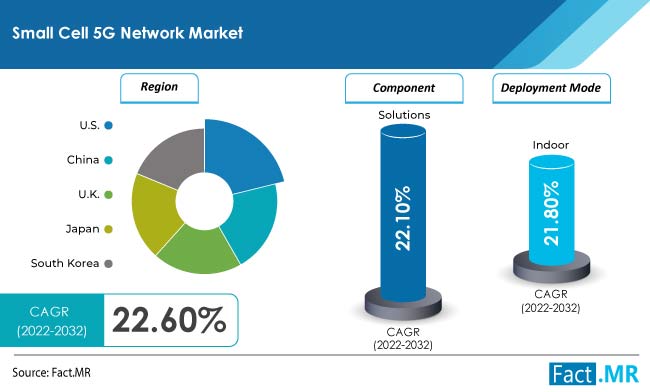The small cell 5G network market is predicted to grow at a steady CAGR of 22.6 percent from now until 2032 and is estimated to be worth around $8.2B in 2032, rising up from $1.1B in 2022, according to a report by Fact.MR.
“The demand for 5G small cells is predicted to rise due to an increase in investment in 5G infrastructure and increased financing for high-speed networks in a number of nations throughout the world,” the report says. “The adoption of a small cell 5G network is predicted to rise due to its features such as ultra-reliable, low-latency communications, the advent of the Citizens Broadband Radio Service band and the Internet of Things.”
The expected growth follows the period from 2015 to 2021, which saw the adoption of small cell 5G networks decline by a CAGR of 22.6 percent because of the COVID-19 pandemic, lockdown and subsequent supply chain woes.
The small cell 5G network market expansion will result from a rise in mobile data traffic around the world by a factor of five by 2032, fuelling network coverage and capacity upgrades. “The demand for small cell 5G networks is rising and as a result, several major firms are investing in the development of small cell networks,” the report says.
Challenges to Growth
The deployment of small cell networks still faces challenges, however. One constraint is the high cost of fiber connectivity and power distribution. The average deployment costs of a small cell network, according to AT&T, Inc., range from $6.8 million to $60 million, depending on whether it is rural or urban. Rural is more expensive.
On the other hand, small cells are used in high-traffic areas or when macrocell coverage is inadequate, and fiber and power are typically unavailable.
Wireless backhaul is one of the potential solutions for this problem, but it depends on unit size reduction and throughput testing, which may increase deployment costs. Backhaul using next-generation satellites provides an alternate, but also a more expensive, option.
“The lack of an alternative backhaul solution provides a substantial obstacle to small cell deployment and operation,” the report says. “As market players of small cell 5G networks overcome these challenges, the demand for small cell 5G networks is likely to witness immense growth during the forecast period.”
U.S. is a Key Small Cell 5G Network Market
The U.S. is estimated to account for the largest market size during the forecast period with a CAGR of 22.4 percent, according to the report, because operators across North America are expected to deploy small cell solutions on their 5G mobile infrastructures.
“Key players in the U.S. are progressively constructing small cells to densify their networks, especially in metropolitan areas, while lowering costs in preparation for 5G installations,” the report says. “As a result of its potential to boost capacity in operator networks across a variety of locations and addresses, the adoption of small cell 5G networks has become increasingly popular across a variety of industrial verticals. This is a significant component driving the rapid expansion of small cell 5G network market share.”
By J. Sharpe Smith, Inside Towers Technology Editor





Reader Interactions